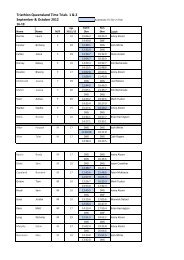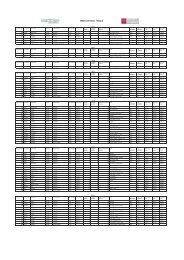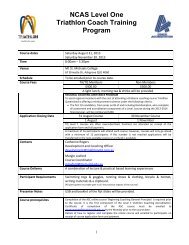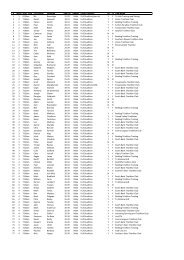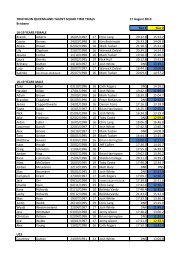Triathlon Event Management & Race Operations ... - Triathlon QLD
Triathlon Event Management & Race Operations ... - Triathlon QLD
Triathlon Event Management & Race Operations ... - Triathlon QLD
You also want an ePaper? Increase the reach of your titles
YUMPU automatically turns print PDFs into web optimized ePapers that Google loves.
<strong>Triathlon</strong><strong>Event</strong><strong>Management</strong>& <strong>Race</strong><strong>Operations</strong> Manual
Contents1.0 Introduction ................................................................................................... 32.0 Pre <strong>Event</strong> Planning ......................................................................................... 42.1 Risk <strong>Management</strong> & Sanctioning ................................................................ 42.1.1 Risk <strong>Management</strong> Plan ........................................................................ 42.1.2 Sanctioning Procedure ......................................................................... 42.2 <strong>Event</strong> Approvals/Permits ............................................................................ 52.3 Promotion/Sponsorship of <strong>Event</strong> ............................................................... 62.4 Organise Volunteers, Staff and Services ..................................................... 72.5 <strong>Operations</strong> (for race weekend) ................................................................... 93.0 <strong>Race</strong> Day <strong>Management</strong> ................................................................................ 113.1 <strong>Event</strong> Logistics/<strong>Operations</strong> ....................................................................... 113.2 <strong>Event</strong> Equipment ...................................................................................... 163.3. Other Important <strong>Race</strong> Operational Items .................................................... 204.0 Post <strong>Event</strong> .................................................................................................... 21Page 2 of 21
1.0 IntroductionThis event operations and management manual has been created to provide new,current triathlon race directors and triathlon clubs a resource to help aid in therunning of an effective and efficient triathlon event.The manual enables event operators to set time frames, identify essential tasks andidentify persons responsible for each task. The manual is divided into three sections;2.0 Pre-<strong>Event</strong>3.0 <strong>Race</strong> Day <strong>Management</strong> and <strong>Operations</strong>4.0 Post-<strong>Event</strong><strong>Triathlon</strong> Queensland is providing this manual to help in the running andcoordination of events. The initiative also aims to increase the holistic quality ofevents by making them safer and better delivered.Page 3 of 21
2.0 Pre <strong>Event</strong> Planning2.1 Risk <strong>Management</strong> & SanctioningRisk <strong>Management</strong> Comments Deadline Person Done CostPrepare Budget/BreakevenAnalysisComplete Risk <strong>Management</strong> PlanSanction <strong>Event</strong>Evaluate previous year’s event2.1.1 Risk <strong>Management</strong> PlanThis must be done for all events that are sanctioned through <strong>Triathlon</strong> Australia. An analysisof potential risks must be undertaken in conjunction with the Risk Matrix; the mostcommonly used table to assess risk.For more information on how to implement a Risk <strong>Management</strong> plan into the running of yourevent please goto; http://www.triathlonqld.com.au/ClubsCoaches/ClubSupportDocuments.aspx2.1.2 Sanctioning ProcedureThe aims of sanctioning a race are to:a) Assist <strong>Race</strong> Organisations and <strong>Race</strong> Directors to stage safe and fair triathlon events.b) Maintain a positive image of the sport of triathlon by setting minimum standards for thestaging of safe races which are accessible to all members of the community.c) Ensure that triathlon events are conducted in accordance with minimum standards ofsafety and fairness on a uniform basis throughout Australia, and in accordance withinternational standards and obligations as required by <strong>Triathlon</strong> Australia’s membership ofthe International <strong>Triathlon</strong> Union.Page 4 of 21
Private race promoter/affiliated clubs: Cover $20 million Premium DoneA. Sanctioned event that allows non-TA members to compete in full triathlonevents (Swin, Bike, Run) and a field greater than 100 entrantsB. All other events (inc. Aquathlon, Duathlon and open Club <strong>Triathlon</strong> eventswith more than 100 entrants).C. Club Sanctioned <strong>Event</strong>s that allows own club members only AND maximumfield 100 entrants (No sanctioning required from TQ, as Club insurance coversthis event).$465.00 $270.00 For more information on Sanctioning and the extra benefits that it brings your event pleasegoto; http://www.triathlonqld.com.au/<strong>Event</strong>s/Howtorunanevent/SanctioningProcess.aspxNil2.2 <strong>Event</strong> Approvals/Permits<strong>Event</strong> Approval Comments Deadline Person Done CostFinalise Venue/<strong>Event</strong>DatesTraffic <strong>Management</strong>Council & VenueApprovalsDepartment ofTransport ApplicationPolice PermitsApplication forms found on websiteApplicable if using state controlled roadsApplication forms found on websiteAquatic Permit Maritime SafetyTraffic <strong>Management</strong> – A Traffic Guidance Scheme needs to be done up for any roads that need to beused for your event. After finalising dates and the venue this should be your first port of call.Council/Venue Approvals – They will require a Traffic <strong>Management</strong> Plan of the event (if<strong>Triathlon</strong>/Duathlon) and site plan with this application. Later add on’s to this will be Police Permitsand Certificate of Currency.Department of Transport – This is only required if your event will be on State Controlled Roads SCR)or you need to put Variable Message Boards (VMS) on the side of SCR. Council should be able toinform you if this is the case.Police Permits – To use a road you will need a Police Permit and if you need police services you willneed to apply for that as well. They again will require Traffic <strong>Management</strong> Plans upon consultationAquatic Permit – This will only be needed if the event swim leg is taking place where boat craftusually reside e.g. out from a boat ramp, in a boat passage etc.Page 5 of 21
2.3 Promotion/Sponsorship of <strong>Event</strong>Promotion of <strong>Event</strong> Comments Deadline Person Done CostOrganise SponsorshipAdvertise on WebsiteE-Mail to previousathletesBrochure, Posters,Flyer, NewsletterCreate Media Release& DistributeRoad ClosureAnnouncement inPapersNotify localResidents/BusinessesNotify Bus lines thatmay be affectedRegister Forms /Online EntriesSponsorship – It is imperative that this is sourced at the very start of the process. It is not fun chasingaround sponsors close to the event date.Local Business/Residents – Local support of an event is integral to the eventual success and longevityof any event. Inform them early to gauge interest and try to smooth over any negativities. Ultimatelylocal backlash can stop an event from taking place in future years.Road Closure Announcement – When closing roads, council require you to put an advert in thegeneral notices section of at least the local newspaper to inform the public of the event. If StateControlled roads are used regional papers may need to be utilisedBus Lines – Clarify with council if your event affects any bus services and if so who will be informingthem of the closures and ways in which they can continue picking up passengers along their affectedroute.Registration – Online companies such as Register Now can be used to handle event registrations inaddition to manual entries (if capability allows)Page 6 of 21
2.4 Organise Volunteers, Staff and ServicesOrganise Volunteers& ServicesMotor CycleMC/ <strong>Race</strong>CommentatorTimingSports Trainer/FirstAid/PhysioPolicePhotographerSound Technician/PAsystemLife SaversSwim CapsBarrier HireMarqueesMedals/ PrizesPortable ToiletsSecurityVolunteers<strong>Race</strong> Referee/TO’sPortable Radio’sAmbulanceFruit & Drink forrecoveryFinish ArchBike Racking/SignsLightingGeneratorFood VendorsComments Deadline Person Done CostApplication forms for special servicesfound on website.Page 7 of 21
Motorcycle – The hiring of motorcycles is required for <strong>Triathlon</strong>’s and Duathlon’s so that TechnicalOfficials can monitor drafting during the race. These bikes will need to be able to seat driver andpassengerMedical – At least two first aid officers are required for the safe running of the event. One must bestationed at the finish and one can effectively utilise the ability to roam.Police – Police will be required where there are implications to normal traffic due to the running ofyour event. They are typically required for the running of <strong>Triathlon</strong>’s and Duathlon’s.Photographer – Determine what kind of things you want from your photographer, competitorphoto’s versus event photo’s. This will determine who you will use.Life Savers – Are required for the safe running of any water activity. Use of at least 1 IRB andpersonnel on boards around course will suffice. Donation to SLSC will be required.Swim Caps – For any event that has a swim leg, swim caps are usually provided as a part of the racecompetitor pack.Barrier Hire – This is for areas such as transition, the finish and recovery area, and if budget allows forthe run course to keep spectators off. Type of Barrier hire depends on budget, e.g. Crowd ControlBarriers can be hired and sponsor banners can easily be attached to these at a higher cost to orangemesh fencing and star pickets. Also affected by what kind of surface is being used, concrete vs. grass.Security – If setting up the night before the event, security will be required overnight to ensure thesafety of expensive equipment.Recovery – Fruit, water (and if budget allows nutritional drink) supplied in recovery area for allparticipating athletes.Food Vendors – Food Vendors such as coffee vans, hot food, cold food, ice creams etc. forparticipants and spectators.Generator – A Generator will need to be present to supply electricity to sound, timing, blow up finisharch, lighting (for early registrations) etc.Lighting – For those cooler months, lighting may be required if registration and bike check-in is takingplace early in the morning. Also look at the need for security to have sufficient lighting overnight.Bike Racking – The accepted amount of bikes to a length of bike racking could be 8 bikes to 2m. Thisratio can differ according to the race directors wants.Page 8 of 21
2.5 <strong>Operations</strong> (for race weekend)<strong>Operations</strong> Comments Deadline Person Done CostCourse Visit (2-3 times)Finalise Course LayoutFinalise <strong>Race</strong> TimesSite PlanCreate InformationBoardsComplete operationalmanualRoad Closure SignageCompetitor InformationkitsFinalise <strong>Event</strong> day runsheet<strong>Race</strong> Briefing DocumentEquipment ChecklistcompleteAccommodationWater Quality TestsVolunteer ManualTechnical OfficialManual<strong>Race</strong> BibsAthlete CompetitorInformationCorrespondence preeventPhotographer ManualPage 9 of 21
Course Visit – This should be done a number of times so as to familiarise yourself with the course. Goover it with an athlete as well to get their view of it as competitors sometimes see a course in adifferent way to an organiser.<strong>Race</strong> Times – Make sure there is as little overlap as possible if holding a number of events on the oneday.Site Plan – This should be one of the first operational aspects completed. It may well get refined aftereach course visit but the main logistics of the course should be sorted when applying for council,police and transport permits.Information Boards – Information should be fixed to a notice board using large print that enablescompetitors to inspect the material prior to the event. The noticeboard should include the followinginformation; decisions on wetsuit swim, wave starts and swim cap colours, a large map of transitionand course, penalties notice board, disqualification & appeals and name of race director technicaldelegate race referee and senior delegates. This should be located near Registration Area.Operational Manual – This will be a working document for the race director and staff. It will outlineeverything that needs to be done at the venue in the lead up to the event, on race-day and packdown. This document has all information in it so that any event leader can step up into another role ifrequired.Road Closure Signage – For events where roads are closed or partially closed then signage along thiscourse to inform the public will be required. Road closure times, roads to be affected and times thatthe roads reopen to full traffic will need to be noted.Competitor Information Kit – The quality of the information provided to competitors before a race isessential to the success of most aspects of an entire event. The mass participation nature of triathlon,combined with the numerous safety issues demands a low tolerance for error in regard to theaccuracy of the information that must be conveyed to competitors. The information included in thismail out will include; info on parking, how to get there, presentation times, when and where resultswill be found, likelihood of wetsuit swim, wave start order and time between, hazards on the course.Athletes now expect to receive a document like this prior to every event.<strong>Event</strong> Day Run Sheet – This document will have all race times, race finishes, registrationopening/closing times, transition opening/closing times. Presentation expected times, and who willbe required to do what task.<strong>Race</strong> Briefing Document – This document will form the overall scope of what is spoken about in thepre-race briefing. <strong>Race</strong> rules, course features etc. will be featured in this document.Accommodation – Ensure that if accommodation is required for staff that this is booked beforeannouncing dates of the event. Many athletes like to stay the night before so as not to rush themorning of an event.Water Quality – If using a water facility where water quality may be a concern, it would be advisableto get the water tested at the beginning of the event process to ensure that the location that youenvisage using for the event is actually suitable.Volunteer Manual – All events are reliant on volunteers, and volunteers that are aware of what isrequired of them are potentially beneficial to your event. This manual will outline where they have tomeet and at what time, the roles that are required to be filled, detailed descriptions of what isrequired of each volunteer role, the amount of time that they are required in that role and what timethey are expected to be finished.Technical Official Manual – This document should have an outline of the timings of the day.Therefore what time your first swimmer finishes and what time your last runner starts. This will alsoinclude; wave start times, transition/registration open and closing times and first and last finish of alllegs.<strong>Race</strong> Bibs – These will need to be done before the event once number of athletes of the event arefinalised. Also numbering for their bags (to be stored at a secure location during the event), and fortheir handle bars will be required. This should all be found in the race competitor packs on the day.Photographer Manual – Ensure that the photographer you have hired knows exactly what kind ofphoto’s required.Page 10 of 21
3.0 <strong>Race</strong> Day <strong>Management</strong>3.1 <strong>Event</strong> Logistics/<strong>Operations</strong>Registration Comments Deadline Person DoneSet up registration area<strong>Race</strong> packs & checklistCourse maps on displayStart/Closing timeProducts/Prize monies as perentry conditions presentedRegistrationCompetitor RegistrationsAn efficient and orderly competitor registration process is essential if a race is to start on time, withcompetitors in a relatively relaxed state. Registrations should commence at least 90 minutes beforethe scheduled race start time, and earlier for larger races. It is normal for many competitors to arrive30 to 60 minutes before the race starts. Registrations should close no later than 15 minutes beforethe race starts so that an official pre-race briefing can be given to all competitors, and to enablecompetitors to make their own final race preparations.The registration process must be properly planned and resourced to ensure registrations occurwithout overcrowding, long queues and time delays. Registrations should take place in an indoor orsheltered outdoor area to ensure wet weather, high winds or darkness do not disrupt the process.Access to power and lighting should be considered.Information and directional signs should be placed above head height, rather than at table level, toenable competitors to find their own way in a crowded area. The registration area should containtable areas for the following purposes:• Late entry form completion area• Late entry cashier• Adequate number of category registration tables, each sharing approximately the samenumber of competitors• Texta body marking areas.Pre-<strong>Race</strong> Day RegistrationsAdditional optional registration times can be offered on race eve to help ease the registration timepressures that exist on race morning. This service could be provided for up to 2 hours anytimebetween 2.00pm and 6.00pm. This period may coincide with the arrival of out of town competitorsand other competitors who wish to inspect the race venue, transition area or course before race day.Page 11 of 21
Competitor Identification NumbersCompetitor identification numbers must be prominently displayed on and by competitors at all timesduring a race. The numbers are essential for timekeeping, responding to medical and otheremergencies, race commentary, enforcing rules and for post-race identification by the media inphotographs and video footage. Competitor identification numbers should include a letter and anumber. Numbers should be displayed on competitor chest plates and texta body markings, eg‘D546’.Transition Area Comments Deadline Person DoneSet up Transition AreaCompound size<strong>Race</strong> Briefing, audible/content<strong>Race</strong> marshals, quantityTQ Officials, quantityOpen/closing timesCompetitor flowSecurityBaggage Area<strong>Race</strong> marshalsCheckout/quantityPublic address systemThe Transition AreaGeneralThe transition area is the area partitioned for the racking of competitors’ bikes and the storage ofclothing, shoes and equipment required for each leg of the race. This acts as the point from whichspectators, media and competitors watch and judge the overall appeal of the race. The generalprinciples to be observed when designing a transition are:• Competitors aim to spend as little time as possible ‘in transition’• Competitor movements should be capable of being swift yet orderly• Entry and exit points should be created so that the positioning of bikes anywhere in thetransition area does not create transition time (dis)advantages• The transition area is a place for competitors only.Page 12 of 21
Bike Rack DesignBike racks should consist of horizontal numbers onto which bikes are hooked. Bikes can be hooked toa rack by the handlebars or seat. The racks should be constructed of strong material such as steel orwood. Horizontal numbers should be attached by ‘A’ framed supports placed at 3 metre intervals toreduce sagging or collapse under the weight of bikes. The racks should be about 1.2 metres high toensure only 1 wheel is off the ground when a bike is hooked on the rack. Dangling bikes are anannoyance to adjacent competitors if their storage area is encroached by other bikes twisting in midair.Bike Rack SpacingBike racks should be placed in parallel rows spread 5 metres apart to create an orderly flow ofcompetitors in and out of the transition area. The gap should be 7 metres for elite draft legal races asthey tend to start and finish the bike leg together and converge on transition area in large groups.Sufficient bike racks should be provided so that each competitor has a storage area 550mm wide tocontain shows and equipment directly beneath their bike. A smaller width will create overcrowdingand make it difficult for competitors to rack their bike at the end of the bike leg.Competitor Access to Transition AreaAt all times, only competitors should be permitted in the transition area. Before the registrationcommences, entry and exit points should be blocked until officials arrive to conduct helmet checksand bike security measures.Competitors should be informed that they may not remove their bike once they enter the transitionarea. This means a competitor cannot subsequently do a cycling warm up on roads outside thetransition area. The <strong>Race</strong> Referee may relax this restriction at smaller races, provided the competitorsubmits to another helmet check on re-entering the transition area. This will not usually be permitted,as it is unreasonable for officials to carry out an excessive number of inspections and risk causing adelay in the start of the race. Competitors may do warm-ups using wind trainers erected next to theirbike storage area.Non Competitors in Transition AreaThe transition area should be a place reserved for competitors before, during and after a race. Accessby non-competing parties is not permitted.Access to the transition area should be consistently and strictly enforced by all officials, particularly atlarge races where overcrowding can have serious consequences. It is important that the <strong>Race</strong> Directorand <strong>Race</strong> Referee liaise before the race to agree and communicate the approach to be taken on thisissue. The rule may be relaxed at smaller and less formal races, but not during the racePage 13 of 21
Swim Course Comments Deadline Person DoneSet up Swim CourseWater SafetyStart/Exit ZoneAccurate distance/measurePassage from exit to transitionWater quality/temperatureTime StartWave startsCycling Course Comments Deadline Person DoneMount/Dismount Area/Line<strong>Race</strong> marshalsCourse direction/clean cornersTQ OfficialsDraft OfficialsPoliceCommunications<strong>Race</strong> marshalsTQ officialsCommunicationsWater stationsRun Course Comments Deadline Person DoneCourse layout, size, efficiencyFirst BikeLast Competitor BikePage 14 of 21
First Aid Area Comments Deadline Person DoneMedical Tent position/visibilityMedical Staff/quantitySecure AreaEase of accessMedical AreaThe medical area is the base from which medical personnel issue first aid to injured competitors andother patrons at the race venue. The medical area should be:• Located where there is a direct and clear path for distressed competitors to be escorted fromthe finish line to the medical area.• Accessible by an ambulance so that seriously injured competitors can be evacuated to ahospital.• Enclosed and partitioned so that first aid can be provided in relative privacy and protectedfrom adverse weather ie. a tent, medical van, building or ambulance.Technical OfficialSignagePenalty Box Comments Deadline Person DoneVolunteersLocationWater Station Comments Deadline Person DoneInformationTask allocationBriefingVolunteers Comments Deadline Person DonePage 15 of 21
3.2 <strong>Event</strong> EquipmentTransition Area Comments Deadline Person DoneEntry/Exit gatesBike racksSignage-gates/entry/exitBarrier legsBroomsCable tiesElectricity supplyFlag BuntingMicrophone handsetsRopeStar picketsStar pickets capsTraffic conesVests for marshals/volunteersGaffa TapeBarrier netting or fencingSponsorship SignageNumbering for RacksRecovery Area Comments Deadline Person DoneChairsCutting boardExtension leadToiletsKnives/CuttersGarbage binsIce – MedicalTablesFruitWater/Nutritional DrinkGlovesPage 16 of 21
Recovery AreaPost-<strong>Race</strong> Food and DrinkOnce competitors have passed the timing area and have been medically assessed, they should bedirected to a recovery area containing refreshments. This area should be partitioned, however,friends and family may enter the area if sufficient space and refreshments are available. Wherepossible, the recovery area should be shaded and located within close proximity to water taps andother amenities. Massage therapists may erect tables in the recovery area and treat competitors freeof charge.Plain tap water must be supplied in paper or plastic cups. Drink sponsor product must not be the soleor exclusive drink supplied after or during a race, as many competitors prefer plain water. All drinksshould be dispensed in to cups from plastic vessels containing lids and taps. Clean plastic garbage binsmay be used provided they are lined with disposable plastic bags.• A typical selection of refreshments provided free of charge after a race includes plain tapwater, apples, bananas and oranges. Subject to finances, additional refreshments such aswatermelon, rockmelon, grapes and energy drinks may be provided.• The quantity of fruit needed will depend on the taste or how ripe the fruit is, how hot theweather is and the availability of other free refreshments. A typical provision may comprise 3orange quarters and 2 banana halves per competitor.• Fruit should be cut into small portions to economise, minimise waste and for ease ofconsumption.• Fruit may be cut the evening before a race, provided it is kept in a cool storage areaovernight. Otherwise a team of cutters with sharp knives and cutting boards shouldcomplete the task on the race day before the first individual competitor completes the race.• Relay team swimmers and cyclists should have access to refreshments as soon as theycomplete their leg.• One must ensure the availability of refreshments to all competitors. One’s race time shouldnot impinge on the availability of providences.Swim Course Comments Deadline Person DoneSwim CapsBuoysTraffic conesStar picketsStar pickets capVests for marshals/volunteersBarrier netting or fencingWater Safety Gear (inflatable,surf rescue)SignagePage 17 of 21
Cycling Course Comments Deadline Person DoneSignageSweep vehicleCrowd controls, barricadesMotor Bike RidersChalkCarpet (for railway lines)Vests for marshals/volunteersSignageRun Course Comments Deadline Person DoneVests for marshals/volunteersBroomsSignageRadiosTraffic conesChalk/SprayFencingHammerMedical TentFirst Aid KidsStretcherFirst Aid Area Comments Deadline Person DonePenalty Box Comments Deadline Person DoneTraffic Cones/BarricadesVest for Technical OfficialViolation ListPage 18 of 21
CupsWaterGlovesWater ContainerWater Station Comments Deadline Person Done<strong>Event</strong> Staff Comments Deadline Person DoneWaterFood Packs<strong>Event</strong> ShirtsVolunteer PacksSunscreen<strong>Event</strong> Operation ManualsRegistration Comments Deadline Person DoneTable/ChairsMarqueeBanners/FlagsPaper, Pencils & PensSharpenerClipboardPermanent MarkerDuct/Sticky TapeBlue TacHighlighterCable Ties & Safety PinsWhite OutScissorsPetty Cash tin & KeyRubber BandsPencil CasePage 19 of 21
3.3. Other Important <strong>Race</strong> Operational ItemsCompetitor Rules and ViolationsAll incidents involving questionable competitor behaviour and rule violations must be referee to the<strong>Race</strong> Referee to decide on a penalty, if any e.g. Disqualification or warning. The rules require strictprocedures to be followed by the <strong>Race</strong> Referee to effect a valid disqualification. Similarly, some ruleviolations can only be dealt with by accredited Technical officials who are trained in the properprocedures.Officials – Assistance to CompetitorsMarshals and other officials not only assist with safety, but also play a critical role in ensuring the raceis fair. Consequently, the way in which officials and marshals help competitors can result in acompetitor being disqualified, even if the competitor did not ask for the assistance given. An officialmust not provide assistance in the following circumstances:• Assistance which is not given to provide for the welfare of all competitors or the public e.g.Verbally advising a competitor of the size of a lead (time or distance) held by anothercompetitor.• Assistance that constitutes an unfair advantage e.g. A drink station marshal cannot save alimited supply of food or drink for a favoured competitor, in so doing denying othercompetitors who would have otherwise received the sustenance.• Assistance which is not consistent with an official’s area of responsibility e.g. A marshalwhose job it is to indicate a direction of a course must not provide sustenance, massage orhelp change a tyre.Spectator Areas and Routes<strong>Triathlon</strong> is an exciting sport, particularly when watched from close range. Like most public events,triathlon spectators tend to gather where they choose, unless physically prevented from doing so.Spectators should be controlled to minimise their risk of interfering with the race eg. colliding with orblocking the passage of competitors. A <strong>Race</strong> Committee also has the duty to care for the safety andcomfort of spectators, particularly near start, finish and transition area.The extent to which spectators can and should be controlled must be balanced against the followingconstraints:• Limited supply of crowd control equipment available to a <strong>Race</strong> Committee• General layout of the course, roads and residences that may make it impossible to physicallypartition spectators from competitors• Many kilometres of roads and paths that comprise a course, on which spectators can gather• The need to allow spectators the ability to move freely in and around a race venue• The right of non triathlon public to access the race venue and adjacent properties• The effect of road closures and partitions on surrounding businesses• The desire of spectators to move around a race venue to watch different stages of the raceeg. swim shoreline to transition area, to run course• The unpredictable tendency for people to put themselves at risk by entering onto the courseeg. young childrenPage 20 of 21
A <strong>Race</strong> Director must prioritise the use of crowd control equipment and marshals to ensure:• The progress of competitors is not unduly impeded by crowds of spectators• The size of a crowd does not create an imminent risk of spectators being forced into thepath of moving competitors.Crowd Control Equipment and MeasuresFree standing grated steel barriersRoad barriers and legsSingle strand flagged bunting or tapeParra-webbing and star picketsReusable fencing wire eg. 7 strand fencingSignageTraffic conesMarshals (with loud hailers)Frequent warning from the race announcerNote: If spectator areas are bisected by the course, a single pedestrian crossing, controlled bymarshals, should be created to concentrate spectator movement and risks at one location.4.0 Post <strong>Event</strong>Post <strong>Event</strong> Tasks Comments Deadline Person Done CostPresentation of awardsSite Pull DownAnnounce the results on thewebsiteVolunteer Officials – reward andrecognitionMedia ReleaseSurvey Competitors<strong>Event</strong> EvaluationFinal ReportCompare Budget to Actual CostStart Again!!!Page 21 of 21




